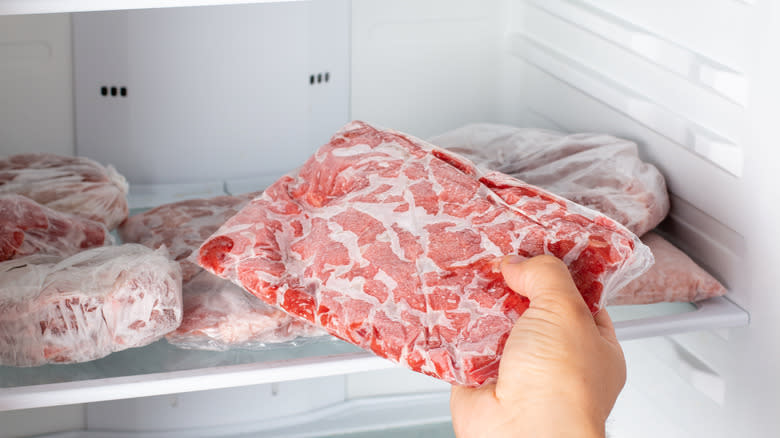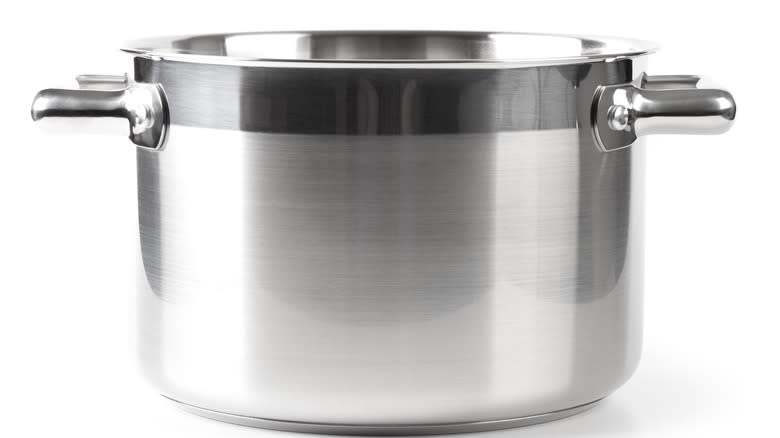Thaw Meat In A Flash With A Clever Cookware Hack

Everyone has been there at one point or another -- it's dinnertime and you realize that you forgot to defrost your meat. You don't have time to let it defrost in the fridge, but not to worry, you can still save your dinner from ending up a disaster. You can thaw meat quickly using this easy cookware hack.
The method is simple enough. It involves wedging your steaks or pork chops between the bottoms of two pots like a metallic sandwich. You're going to use an upside-down pot as your base, serving as a flat, metallic surface. From there, you'll set your meat down and place a pot of water on top of it. To ensure that you keep the meat's juices, you want to make sure your meat (whether it be beef, chicken, or fish) is wrapped in plastic, but the layers should be thin.
You're going to fill the top pot full of room-temperature water. It's important to make sure that your water isn't too cold or too hot, as that will affect the thawing times and texture of the meat. Depending on the thickness of the meat, your meat should be defrosted and ready to eat in under half an hour. Who knew that a couple of kitchen pots could be your meat-thawing saviors?
Read more: The 13 Best Steaks For Grilling
The Science Behind This Defrost Method

According to the National Library of Medicine, water is a useful tool in thawing meat, thanks to a little thing called heat convection. Heat is transferred from the lukewarm water to the frozen meat, where it is then conducted directly into the meat's fibers. Think of it as a transfer of heat -- the water shares its heat with the frozen meat causing it to defrost. While you may be tempted to use hot water to speed up the process, you should never do this. It's one of several mistakes to avoid while defrosting meat.
According to the USDA, once the meat reaches a temperature of 40 degrees Fahrenheit, any bacteria present in the meat at freezing will begin to expand and multiply. This is known as the "danger zone." By using hot water, you'll unevenly thaw the meat, exposing the outer layers of the meat to higher temperatures while the center may take longer to thaw. It may also affect the texture of your meat, so it's better to use room temperature water for a more even thaw.
Likewise, metal helps speed up that conductive process since metal itself is a conductor. By using two pots, heat from the water is passed back and forth between the metal, thawing the meat. This makes it a quick and efficient way to defrost meat, but is it the best way to defrost?
The Best Way To Defrost Meat

First of all, it's worth pointing out some of the limitations of the defrost method above. While it works well with thinner, flatter pieces of meat, you may run into difficulties trying to defrost a more robust cut like a tenderloin or pot roast. Since such cuts aren't particularly flat, they may thaw unevenly. Still, it's hard to argue with the results of this method compared to other ways of defrosting meat.
Defrosting meat in the fridge can take up to a full day, making it less than ideal for last-minute dinner plans. Likewise, you should never thaw your food via countertop due to the dangers of bacteria growth, as mentioned by the USDA. When it comes to defrosting meat in the microwave, you will have faster results, but this method will affect the overall texture of your meat as the outside will begin to cook before the inside. In comparison, the cooking pot method should prevent any loss of quality in the meat.
Finally, some people prefer to defrost their meat by running cold water over the meat. This will take longer due to the colder temperature and also waste water in the process, as well. In certain situations, such as cooking steaks or pork chops, consider using this hack to speed up the thawing process. After all, no one wants to wait all night to eat.
Read the original article on Daily Meal.

